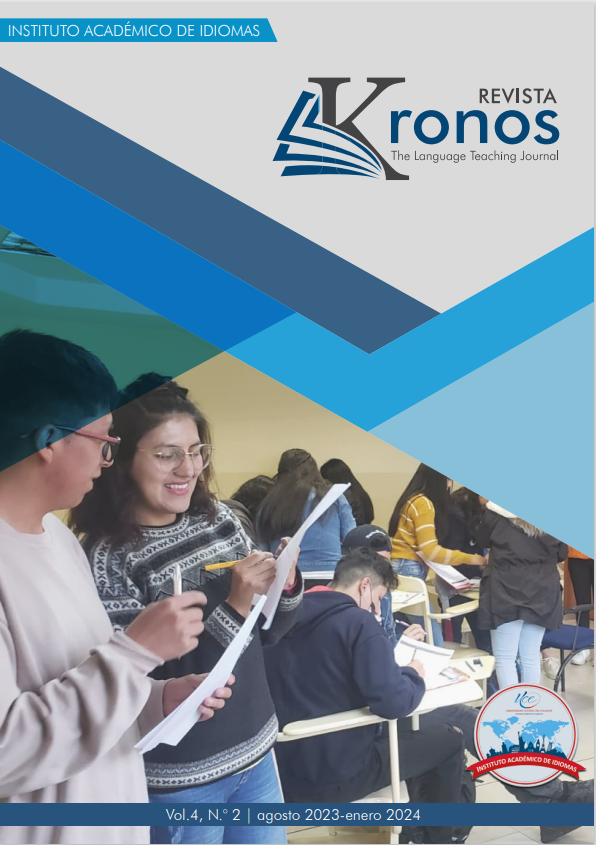Conciencia morfológica para el desarrollo de la competencia léxica del idioma inglés
DOI:
https://doi.org/10.29166/kronos.v4i2.4696Palabras clave:
Conciencia morfológica, competencia léxica, flexión, derivación, composición léxica, amplitud de vocabulario, profundidad de vocabulario, organización del vocabulario, aprendizaje de idiomasResumen
Este estudio se centra en los estudiantes de inglés como segunda lengua y su limitado dominio del vocabulario. Se reconoce que la conciencia morfológica es crucial para el desarrollo de la competencia léxica. Esta revisión explora las implicaciones de la conciencia morfológica (estructura, análisis y decodificación) en la competencia lexical (amplitud, profundidad y organización del vocabulario). La metodología empleada es socioeducativa, bibliográfica, descriptiva y documental. La técnica de transferencia facilitó la recopilación y el análisis de los registros bibliográficos pertinentes. Se utilizaron bases de datos como ERIC, Scopus, Wiley Online Library, ABELL, Google Scholar, repositorios universitarios y revistas internacionales; a su vez, los filtros manuales y las palabras clave mejoraron la recopilación de información. Los resultados demuestran que la conciencia morfológica mejora significativamente la competencia léxica en inglés en todas sus dimensiones. La comprensión de las formas flexivas, derivativas y compuestas aumenta la amplitud, profundidad y organización del vocabulario. Este conocimiento facilita el reconocimiento, la comprensión, las relaciones, los matices y los significados de las palabras. Apreciar los patrones morfológicos ayuda a clasificar y ordenar las palabras, y su papel fundamental en el aumento de la competencia léxica favorece la organización, la profundidad y la amplitud del vocabulario. Los educadores pueden aplicar técnicas de enseñanza eficaces, haciendo hincapié en la inflexión, la derivación y la composición léxica, para mejorar la competencia léxica de los estudiantes y su dominio del inglés, aprovechando el alcance de la conciencia morfológica.
Descargas
Citas
Apel, K. (2014). A Comprehensive Definition of Morphological Awareness: Implications
for Assessment. Topics in Language Disorders, 34(3), 197-209. https://doi.org/10.1097/
TLD.0000000000000019
Azad, M. T., & Ahmadian, M. (2021). Comparing the Effect of Morphological Analysis and
Incidental Learning on the Acquisition of toefl Vocabulary, 45(3).
Berg, K., Buchmann, F., Dybiec, K., & Fuhrhop, N. (2014). Morphological spellings in
English. Written Language & Literacy, 17(2), 282-307. https://doi.org/10.1075/
wll.17.2.05ber
Berninger, V. W., Abbott, R. D., Nagy, W., & Carlisle, J. (2010). Growth in Phonological,
Orthographic, and Morphological Awareness in Grades 1 to 6. Journal of Psycholinguistic Research, 39(2), 141-163. https://doi.org/10.1007/s10936-009-9130-6
Berns, M. S., & Brown, K. (2010). Concise encyclopedia of applied linguistics. Elsevier.
Brandes, D. R., & McMaster, K. L. (2017). A Review of Morphological Analysis Strategies on
Vocabulary Outcomes with ells.
Brown, E. K., Barber, A., & Stainton, R. J. (2010). Concise encyclopedia of philosophy of
language and linguistics. Elsevier.
Carlisle, J. F. (2000). Awareness of the structure and meaning of morphologically complex words:
Impact on reading. 12, 169-190.
Carlisle, J. F., McBride-Chang, C., Nagy, W., & Nunes, T. (2010). Effects of Instruction in
Morphological Awareness on Literacy Achievement: An Integrative Review. Reading
Research Quarterly, 45(4), 464-487. https://doi.org/10.1598/RRQ.45.4.5
Chapelle, C. A. (1999). Construct definition and validity inquiry in sla research. En L.
F. Bachman & A. D. Cohen (Eds.), Interfaces between Second Language Acquisition and
Language Testing Research (1.a
ed., pp. 32-70). Cambridge University Press. https://
doi.org/10.1017/CBO9781139524711.004
Chapelle, C. A., & Sauro, S. (Eds.). (2017). The Handbook of Technology and Second Language Teaching and Learning (1.a
ed.). Wiley. https://doi.org/10.1002/9781118914069
Choi, H.-Y. (2013). Effects of Depth and Breadth of Vocabulary Knowledge on English Reading
Comprehension Among Korean High School Students, 49(3), 419-452.
Choi, W., Tong, X., Law, K. K.-S., & Cain, K. (2018). Within- and cross-language contributions of morphological awareness to word reading development in Chinese–English
bilingual children. Reading and Writing, 31(8), 1787-1820. https://doi.org/10.1007/
s11145-017-9770-0
Choudhury, A. S. (2015). Second/Foreign Language Lexical Competence: Its Dimensions
and Ways of Measuring it. I-Manager’s Journal on English Language Teaching, 5(3),
-42. https://doi.org/10.26634/jelt.5.3.3563
Cleary, A. M. (2014). The Sense of Recognition during Retrieval Failure. En Psychology
of Learning and Motivation (Vol. 60, pp. 77-112). Elsevier. https://doi.org/10.1016/
B978-0-12-800090-8.00003-2
Coch, D., Hua, J., & Landers‐Nelson, A. (2020). All morphemes are not the same: Accuracy
and response times in a lexical decision task differentiate types of morphemes. Journal
of Research in Reading, 43(3), 329-346. https://doi.org/10.1111/1467-9817.12306
Cui, Y. (2009). The Development of Lexical Organization in Chinese efl learners at Tertiary
Level. 16, 57-73.
Deacon, S. H., Tong, X., & Francis, K. (2017). The relationship of morphological analysis and morphological decoding to reading comprehension: Morphological Analysis
and Morphological Decoding. Journal of Research in Reading, 40(1), 1-16. https://doi.
org/10.1111/1467-9817.12056
Deng, T., Shi, J., Dunlap, S., Bi, H., & Chen, B. (2016). Morphological knowledge affects
processing of L2 derivational morphology: An event-related potential study. Journal
of Neurolinguistics, 37, 47-57. https://doi.org/10.1016/j.jneuroling.2015.09.001
Publicado
Cómo citar
Número
Sección
Licencia
Derechos de autor 2023 Carlos Díaz

Esta obra está bajo una licencia internacional Creative Commons Atribución-NoComercial-CompartirIgual 4.0.












